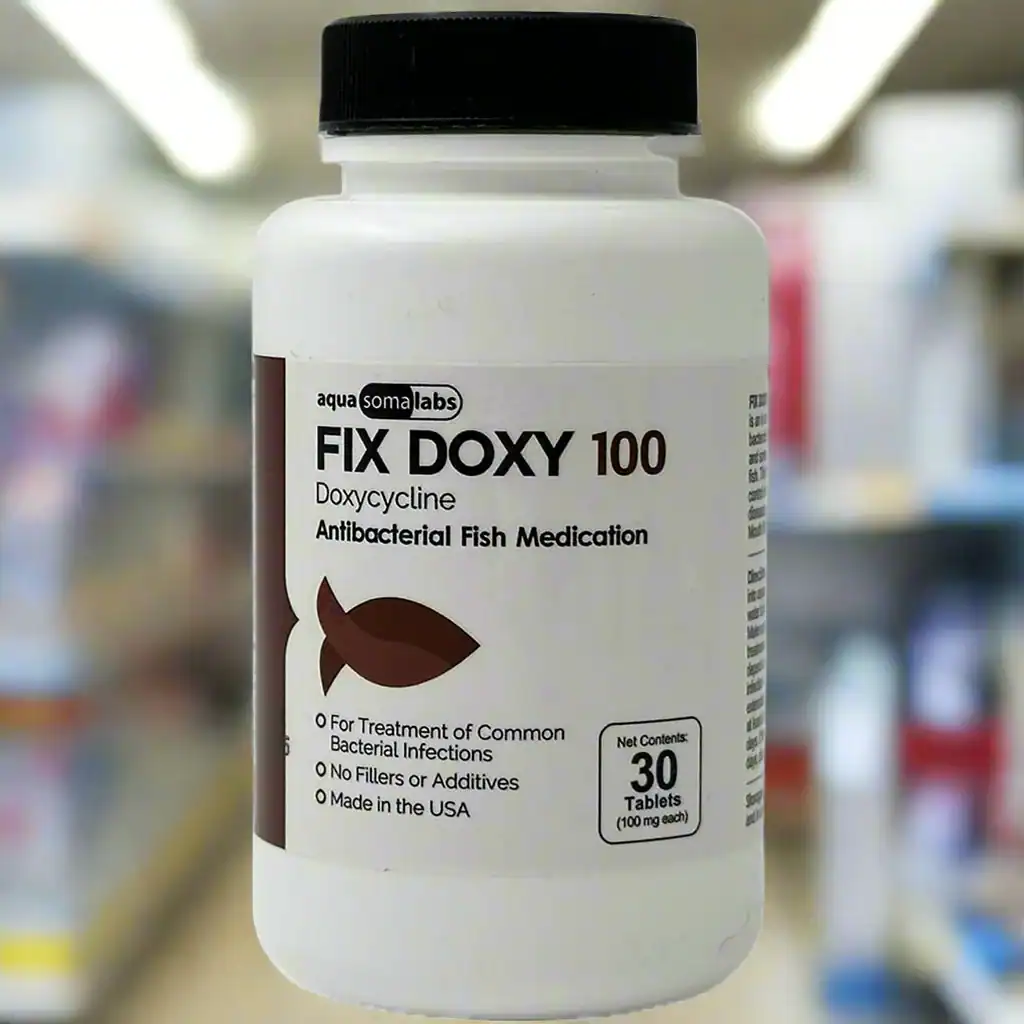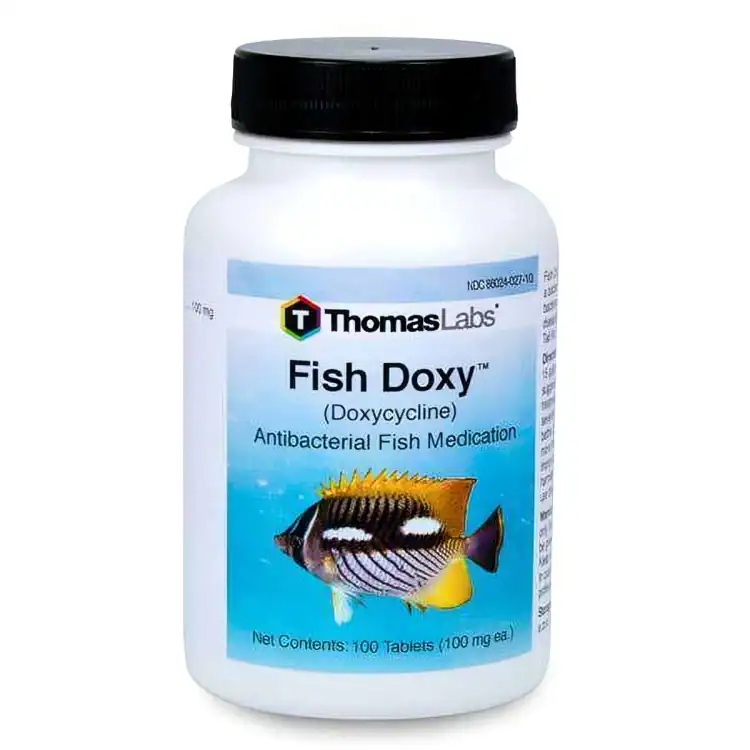Caring for aquarium fish requires an understanding of fish health and the potential diseases that can affect them. One common treatment option is the use of fish antibiotics like doxycycline. This article explores the role of doxycycline in maintaining fish health, its uses, and the appropriate dosages for common fish diseases.
Fish antibiotics are medications used to treat bacterial infections in fish. These antibiotics are similar to those used in human and veterinary medicine but are specifically formulated for aquatic animals. Fish antibiotics, like doxycycline, play a crucial role in ensuring the health and longevity of your aquatic pets.
Fish antibiotics serve as a crucial line of defense against bacterial infections that can swiftly impact an aquarium. These infections can spread rapidly due to the enclosed nature of an aquarium environment, making timely and effective treatment essential. Antibiotics such as doxycycline help control the spread of bacteria, ensuring a healthier environment for your fish.
While fish antibiotics share similarities with human antibiotics, they are specifically dosed and formulated for aquatic use. The primary difference lies in their concentration and the method of administration. Fish antibiotics are often administered through water, allowing the medication to reach the fish through their gills, while human antibiotics are typically ingested or injected.
Accurate diagnosis of fish diseases is critical before administering any antibiotic treatment. Misdiagnosing a condition can lead to ineffective treatment and potential harm to the fish. Understanding symptoms and consulting with a fish health specialist can help ensure the correct use of antibiotics, improving recovery chances.
Doxycycline is a broad-spectrum antibiotic that belongs to the tetracycline group. It is widely used in both human and veterinary medicine due to its effectiveness against a wide range of bacterial infections. In the aquatic world, doxycycline is a go-to medication for treating bacterial infections in fish.
Doxycycline works by inhibiting the protein synthesis of bacteria, effectively stopping their growth and reproduction. This mechanism allows it to combat a variety of bacterial strains, making it a versatile treatment option. By disrupting the bacteria’s ability to multiply, doxycycline aids in controlling and reducing infection spread.
In both human and veterinary medicine, doxycycline is highly valued for its efficacy against numerous infections. It is commonly prescribed for respiratory infections, skin conditions, and certain types of bacterial outbreaks. This widespread use underscores its reliability and adaptability across different species, including fish.
In the context of aquariums, doxycycline is often utilized to address infections that threaten fish health. These infections can arise from poor water quality, stress, or the introduction of new fish. As a result, doxycycline serves as an essential tool for aquarium enthusiasts aiming to maintain a healthy aquatic ecosystem.
Doxycycline is used to treat a variety of bacterial infections in fish, including:
- Fin Rot: A common condition characterized by the deterioration of the fins and tail.
- Columnaris: Caused by the bacterium Flavobacterium columnare, this disease affects the skin, gills, and fins of fish.
- Bacterial Gill Disease: This condition affects the gills, leading to difficulty in breathing and can be fatal if left untreated.
- Aeromonas Infections: These can cause ulcers and hemorrhagic septicemia in fish.
Fin Rot is one of the most prevalent diseases in aquarium fish, often resulting from poor water conditions or physical damage. The condition is marked by frayed and discolored fins, which can progress to more severe tissue damage if untreated. Doxycycline helps halt the bacterial infection, allowing the fins to regenerate and heal.
Columnaris is a highly contagious bacterial infection that can devastate fish populations. It manifests as white or grayish spots on the skin, fins, and gills, sometimes leading to tissue necrosis. Timely administration of doxycycline can prevent the spread of this bacterium, safeguarding the rest of the aquarium inhabitants.
Bacterial Gill Disease poses a serious threat as it impairs the fish’s ability to breathe, often causing lethargy and gasping at the water’s surface. By targeting the bacteria responsible, doxycycline alleviates these symptoms, improving the fish’s respiratory function and overall well-being.
Aeromonas infections are notorious for causing severe ulcerations and internal hemorrhaging in fish. Such infections can quickly lead to systemic issues if not addressed. Doxycycline’s broad-spectrum capabilities make it an effective agent in reducing Aeromonas populations and promoting recovery.
Doxycycline is preferred in many cases because it is effective against both Gram-positive and Gram-negative bacteria. Its broad-spectrum nature allows it to tackle a wide range of bacterial infections, making it a versatile choice for fish enthusiasts.
Broad-spectrum antibiotics like doxycycline are especially beneficial in aquarium settings where the exact bacterial pathogen may not be immediately identified. Their ability to target multiple bacterial types simultaneously reduces the risk of treatment delays and enhances the chances of successful recovery.
Doxycycline is considered safe when used correctly, with a low incidence of adverse effects in fish. Its favorable safety profile makes it a reliable choice for hobbyists and professionals alike, providing peace of mind when treating valuable or sensitive fish species.
Beyond its effectiveness, doxycycline is also a cost-effective option for managing fish diseases. Compared to some specialized treatments, doxycycline offers a balance of affordability and efficacy, allowing aquarium owners to maintain fish health without incurring excessive costs.
Determining the correct dosage of doxycycline for fish is crucial for effective treatment. It’s important to follow recommended guidelines to avoid under-dosing or over-dosing, which can lead to treatment failure or toxicity.
The general dosage of doxycycline for treating bacterial infections in fish is approximately 100 mg per 10 gallons of water. This dosage can vary depending on the severity of the infection and the specific needs of the fish species.
Several factors can influence the appropriate dosage of doxycycline for fish, including the size and species of the fish, the severity of the infection, and the water conditions. Larger fish may require higher doses, while sensitive species may need adjustments to avoid adverse effects.
Accurate dosage calculations are vital to ensure the effectiveness of the treatment. Use precise measurements to determine the water volume of your aquarium and adjust the dosage accordingly. Miscalculations can lead to insufficient treatment or potential overdosing.
Different bacterial infections may necessitate variations in doxycycline dosage. More severe infections might require prolonged treatment durations or increased dosages, while milder cases could be resolved with a standard approach. Consult with a fish health expert for tailored recommendations.

- Calculate the Volume of Your Aquarium: Before administering doxycycline, calculate the total volume of your aquarium to determine the correct dosage. This ensures that the medication is evenly distributed and effective.
- Prepare the Treatment: Dissolve the appropriate amount of doxycycline in a small amount of aquarium water before adding it to the tank. This helps in even distribution and ensures that the fish receive the correct dosage.
- Monitor Your Fish: Keep a close eye on your fish during treatment. Observe any changes in behavior or signs of improvement. If any adverse reactions occur, discontinue the treatment and consult a veterinarian experienced in fish health.
- Repeat if Necessary: In some cases, a single treatment may not be sufficient. If symptoms persist, a second round of treatment may be necessary. However, always allow a break between treatments to avoid stressing the fish.
When preparing the doxycycline treatment, it is crucial to ensure that the medication is thoroughly dissolved before adding it to the aquarium. This helps achieve uniform distribution throughout the water, maximizing the treatment’s effectiveness and reducing the likelihood of localized overdosing.
During treatment, closely monitor your fish for any changes in behavior, such as increased activity or lethargy. Behavioral shifts can indicate the treatment’s effectiveness or signal potential adverse reactions. Maintaining a detailed observation log can aid in tracking progress and making informed decisions.
Treatment duration with doxycycline should be tailored to the specific infection and fish response. While some cases may resolve in a few days, others might require extended treatment periods. Regular evaluations and consultations with a fish health specialist can guide the appropriate treatment length.
In the event of adverse reactions, such as increased stress or unusual behavior, promptly discontinue the treatment and seek professional advice. Immediate intervention can prevent further complications and ensure the well-being of the fish. An experienced veterinarian can provide guidance on alternative treatment options.
- Water Quality: Ensure that the water quality is optimal before starting treatment. Poor water conditions can exacerbate the illness and reduce the effectiveness of the antibiotic.
- Consultation: It is advisable to consult with a veterinarian or a fish health expert before starting any antibiotic treatment to ensure the correct diagnosis and treatment plan.
- Compatibility with Other Treatments: When using doxycycline, consider its compatibility with other medications or treatments being administered in the aquarium. Some combinations can lead to reduced efficacy or adverse interactions.
Before initiating doxycycline treatment, verify that water parameters such as pH, ammonia, nitrites, and nitrates are within acceptable ranges. Imbalances in these factors can stress fish and hinder their recovery, highlighting the importance of pre-treatment water testing and adjustments.
Seeking professional guidance is instrumental in developing an effective treatment strategy. Veterinarians and fish health experts can provide insights into the nature of the infection, appropriate dosages, and potential complications, ensuring a comprehensive approach to managing fish health.
When administering doxycycline alongside other treatments, carefully assess any potential interactions. Some medications can alter the absorption or efficacy of doxycycline, necessitating adjustments in treatment protocols. Expert consultations can help navigate these complexities.
While doxycycline is generally safe for fish, it is important to be aware of potential side effects. Overdosing can lead to toxicity, which may manifest as lethargy, loss of appetite, or even death. Always adhere to recommended dosages and consult a professional if in doubt.
Signs of doxycycline toxicity in fish can include unusual swimming patterns, disorientation, and changes in appetite. Early recognition of these symptoms allows for timely intervention and mitigation of potential risks, minimizing harm to the fish.
To reduce the risk of overdosing, meticulously follow dosage guidelines and employ accurate measurement tools. Consistency in dosing and adherence to treatment schedules are essential to prevent excessive exposure to the medication and associated complications.
After completing doxycycline treatment, continue monitoring the fish for any lingering or emerging side effects. Post-treatment observation can identify delayed reactions and facilitate prompt responses, safeguarding the long-term health of the aquarium inhabitants.
Preventing fish diseases is always preferable to treating them. Here are some tips to maintain a healthy aquarium environment:
- Regular Water Changes: Perform regular water changes to maintain optimal water quality and reduce stress on your fish.
- Proper Filtration: Ensure that your aquarium has an efficient filtration system to remove waste and maintain water quality.
- Balanced Diet: Provide a balanced diet to your fish to boost their immune system and overall health.
- Quarantine New Arrivals: Quarantine new fish for a few weeks before introducing them to your main tank. This helps prevent the spread of diseases.
A consistent maintenance routine, including scheduled water changes and equipment checks, helps sustain a stable environment for fish. Regularly inspecting and cleaning filtration systems ensures efficient waste removal, reducing the risk of bacterial buildup and disease outbreaks.
Providing a varied and nutritious diet supports fish health and resilience against diseases. High-quality fish foods enriched with essential vitamins and minerals strengthen immune systems, enhancing the fish’s natural ability to fend off infections and recover from illnesses.
Quarantining new fish is a critical preventive measure that minimizes the risk of introducing pathogens into the main aquarium. During the quarantine period, observe the new arrivals for any signs of disease, allowing for timely intervention before they are integrated into the larger fish community.
Doxycycline is an effective antibiotic for treating common fish diseases, but it must be used with care. By understanding the proper dosages and taking preventive measures, you can ensure the health and well-being of your aquarium fish. Always seek professional advice if you are unsure about the treatment process. With the right care, your fish can thrive in a healthy aquatic environment.
Remember, maintaining fish health is not just about treating diseases, but also about creating a balanced ecosystem where your aquatic pets can thrive.
Creating a balanced ecosystem involves not only addressing health issues as they arise but also fostering conditions that promote overall well-being. This includes maintaining appropriate water parameters, ensuring sufficient space, and promoting a harmonious community of fish and plants.
Continuously educating oneself about fish care and disease prevention is vital for long-term success in aquarium management. Staying informed about the latest research and treatment options empowers aquarium owners to make informed decisions, contributing to healthier and more vibrant fish communities.
Engaging with fellow fish enthusiasts and experts can provide valuable insights and support. Participating in forums, attending workshops, and sharing experiences enrich the collective knowledge of the community, fostering a collaborative environment for advancing fish health and care practices.


